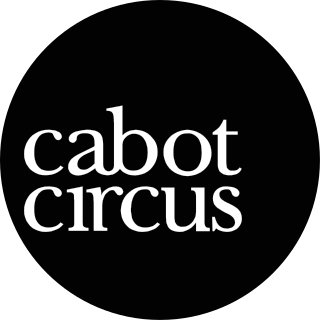
Broadmead is a street in the central area of Bristol, England, which has given its name to the principal shopping district of the city.

Cribbs Causeway is a road in South Gloucestershire, England, just north of Bristol, which has given its name to the surrounding area, a large out-of-town shopping centre, including retail parks and an enclosed shopping centre known as The Mall. Cribbs Causeway road is situated west of Patchway, although in the civil parish of Almondsbury.

Oriental City was a shopping centre in Colindale, London, originally built by Yaohan of Japan, as a luxury Japanese shopping center. After Yaohan filed for bankruptcy in the late 1990s, it became a lower-end mall specialising in various oriental foods and items. It was located on Edgware Road, near Colindale tube station. It had a dedicated car park, and 2 floors. The complex was closed for redevelopment on 1 June 2008 and, after several changes of ownership, was demolished in August 2014.
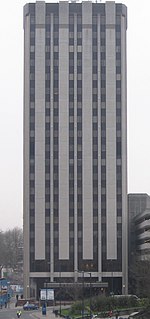
Castlemead is the tallest high-rise building in Bristol, England. Designed by A.J. Hines and started in 1973, work was halted by a recession in the property market and it was completed in 1981. The building has a roof height of 80 metres or 262 feet and consists of 18 floors, 17 of which are offices. Castlemead is owned by Regional Properties Ltd and managed by Knight Frank LLP.
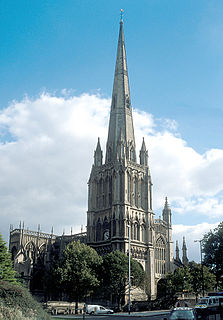
Bristol, the largest city in South West England, has an eclectic combination of architectural styles, ranging from the medieval to 20th century brutalism and beyond. During the mid-19th century, Bristol Byzantine, an architectural style unique to the city, was developed, and several examples have survived.

The Galleries, is a shopping mall situated in the Broadmead shopping centre in Bristol city centre, England. Functioning as one of the city's retail malls, it is a three-storey building, which spans over Fairfax Street.

The English city of Bristol has a number of parks and public open spaces.

Quakers Friars is a historic building in Broadmead, Bristol, England.
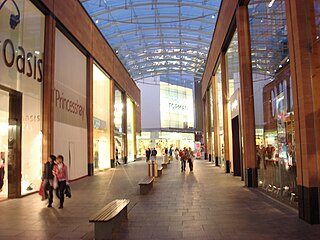
Princesshay is a shopping precinct in the city of Exeter, Devon, England. It was built in the early 1950s to replace buildings that had been severely damaged in the World War II Baedeker Blitz. From 2005 the precinct and some surrounding buildings were demolished and rebuilt as a new shopping centre that opened in September 2007.
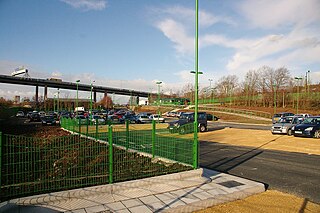
The Portway Park and Ride site is located on the A4 Portway at Shirehampton, to the North West of Bristol, England, adjacent to junction 18 of the M5 motorway.

The Carriage Works are in Stokes Croft, Bristol, England.

Old Market is a Conservation Area of national significance, to the east of the city centre in Bristol, England. Old Market Street and West Street form the central axis of the area, which is approximately bounded by New Street and Lawfords Gate to the north, Trinity Road and Trinity Street to the east, Unity Street and Waterloo Road to the south and Temple Way Underpass to the west.

The Library of Birmingham is a public library in Birmingham, England. It is situated on the west side of the city centre at Centenary Square, beside the Birmingham Rep and Baskerville House. Upon opening on 3 September 2013, it replaced Birmingham Central Library. The library, which is estimated to have cost £188.8 million, is viewed by the Birmingham City Council as a flagship project for the city's redevelopment. It has been described as the largest public library in the United Kingdom, the largest public cultural space in Europe, and the largest regional library in Europe. 2,414,860 million visitors came to the library in 2014 making it the 10th most popular visitor attraction in the UK.

St Jude's is an area of central Bristol, England. It takes its name from the former Church of England parish church of St Jude the Apostle, which was designed by Samuel Burleigh Gabriel and completed in 1849.

Gateway House in Manchester, England, is a modernist office block above a row of shops designed by Richard Seifert & Partners and completed in 1969. It replaced a row of 19th-century railway warehouses on the approach to Manchester Piccadilly station. The building, which differed from much of Seifert's contemporary work in that it departed from the bare concrete brutalist style which had become his trademark, was nicknamed the "lazy S" and was reputedly designed as a doodle.

Finzels Reach is a 4.7-acre (1.9 ha) mixed use development site located in central Bristol, England, on a former industrial site, which occupies most of the south bank of Bristol Floating Harbour between Bristol Bridge and St Philip's Bridge, across the river from Castle Park.

Wine Street, together with High Street, Broad Street and Corn Street, is one of the four cross streets which met at the Bristol High Cross, the heart of Bristol, England when it was a walled mediaeval town. From this crossroads Wine Street runs along a level ridge approximately 175m north-eastwards to the top of Union Street.

Westmoreland House is an abandoned building at Nos. 104–106 Stokes Croft, Bristol, next door to the Carriage Works.




